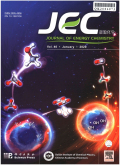- 钛学术文献服务平台 \
- 学术期刊 \
- 工业技术期刊 \
- 石油与天然气工业期刊 \
- 能源化学期刊 \
Confined Ni-In intermetallic alloy nanocatalyst with excellent coking resistance for methane dry reforming
Confined Ni-In intermetallic alloy nanocatalyst with excellent coking resistance for methane dry reforming
基本信息来源于合作网站,原文需代理用户跳转至来源网站获取
摘要:
Carbon dioxide and methane are two main greenhouse gases which are contributed to serious global warming.Fortunately,dry reforming of methane (DRM),a very important reaction developed decades ago,can convert these two major greenhouse gases into value-added syngas or hydrogen.The main prob-lem retarding its industrialization is the seriously coking formation upon the nickel-based catalysts.Herein,a series of confined indium-nickel (In-Ni) intermetallic alloy nanocatalysts (InxNi@SiO2) have been prepared and displayed superior coking resistance for DRM reaction.The sample containing 0.5 wt.% of In loading (In0.5Ni@SiO2) shows the best balance of carbon deposition resistance and DRM reac-tivity even after 430 h long term stability test.The boosted carbon resistance can be ascribed to the con-finement of core-shell structure and to the transfer of electrons from Indium to Nickel in In-Ni intermetallic alloys due to the smaller electronegativity of In.Both the silica shell and the increase of electron cloud density on metallic Ni can weaken the ability of Ni to activate C-H bond and decrease the deep cracking process of methane.The reaction over the confined InNi intermetallic alloy nanocata-lyst was conformed to the Langmuir-Hinshelwood (L-H) mechanism revealed by in situ diffuse reflec-tance infrared Fourier transform spectroscopy (in-situ DRIFTS).This work provides a guidance to design high performance coking resistance catalysts for methane dry reforming to efficiently utilize these two main greenhouse gases,

推荐文章
Ni-In合金电极的制备及其电催化活性
Ni-In合金电极
循环伏安
电催化
葡萄糖
Diel methane flux from a subtropical eutrophic pond in November based on continuous monitoring
Methane
Eutrophic pond
Diffusive
Ebullition
Flux
高温悬浮稳定剂DRY-S2的研究及应用
水泥浆
高温
固井
固井质量
悬浮稳定剂
应用
Hydrodynamic characteristics of Wujiangdu Reservoir during the dry season—a case study of a canyon r
Canyon reservoir
Hydrodynamic characteristics
A transition zone
Wujiang River
内容分析
关键词云
关键词热度
相关文献总数
(/次)
(/年)
引文网络
引文网络
二级参考文献 (0)
共引文献 (0)
参考文献 (0)
节点文献
引证文献 (0)
同被引文献 (0)
二级引证文献 (0)
2022(0)
- 参考文献(0)
- 二级参考文献(0)
- 引证文献(0)
- 二级引证文献(0)
引文网络交叉学科
相关学者/机构
期刊影响力
能源化学
主办单位:
中国科学院大连化学物理研究所
中国科学院成都有机化学研究所
出版周期:
双月刊
ISSN:
2095-4956
CN:
10-1287/O6
开本:
出版地:
大连市中山路457号
邮发代号:
创刊时间:
语种:
eng
出版文献量(篇)
2804
总下载数(次)
0
总被引数(次)
7996
期刊文献
相关文献
推荐文献
- 期刊分类
- 期刊(年)
- 期刊(期)
- 期刊推荐
一般工业技术
交通运输
军事科技
冶金工业
动力工程
化学工业
原子能技术
大学学报
建筑科学
无线电电子学与电信技术
机械与仪表工业
水利工程
环境科学与安全科学
电工技术
石油与天然气工业
矿业工程
自动化技术与计算机技术
航空航天
轻工业与手工业
金属学与金属工艺
能源化学2022
能源化学2021
能源化学2020
能源化学2019
能源化学2018
能源化学2017
能源化学2016
能源化学2015
能源化学2014
能源化学2013
能源化学2012
能源化学2011
能源化学2010
能源化学2009
能源化学2008
能源化学2007
能源化学2006
能源化学2005
能源化学2004
能源化学2003
能源化学2002
能源化学2001

 免费查重
免费查重










